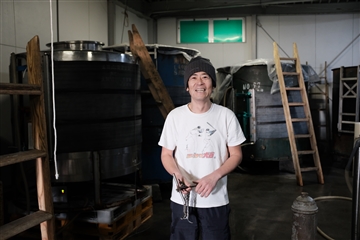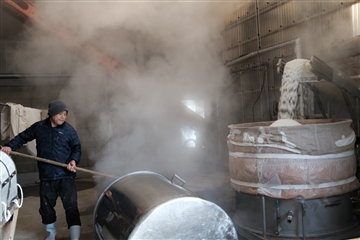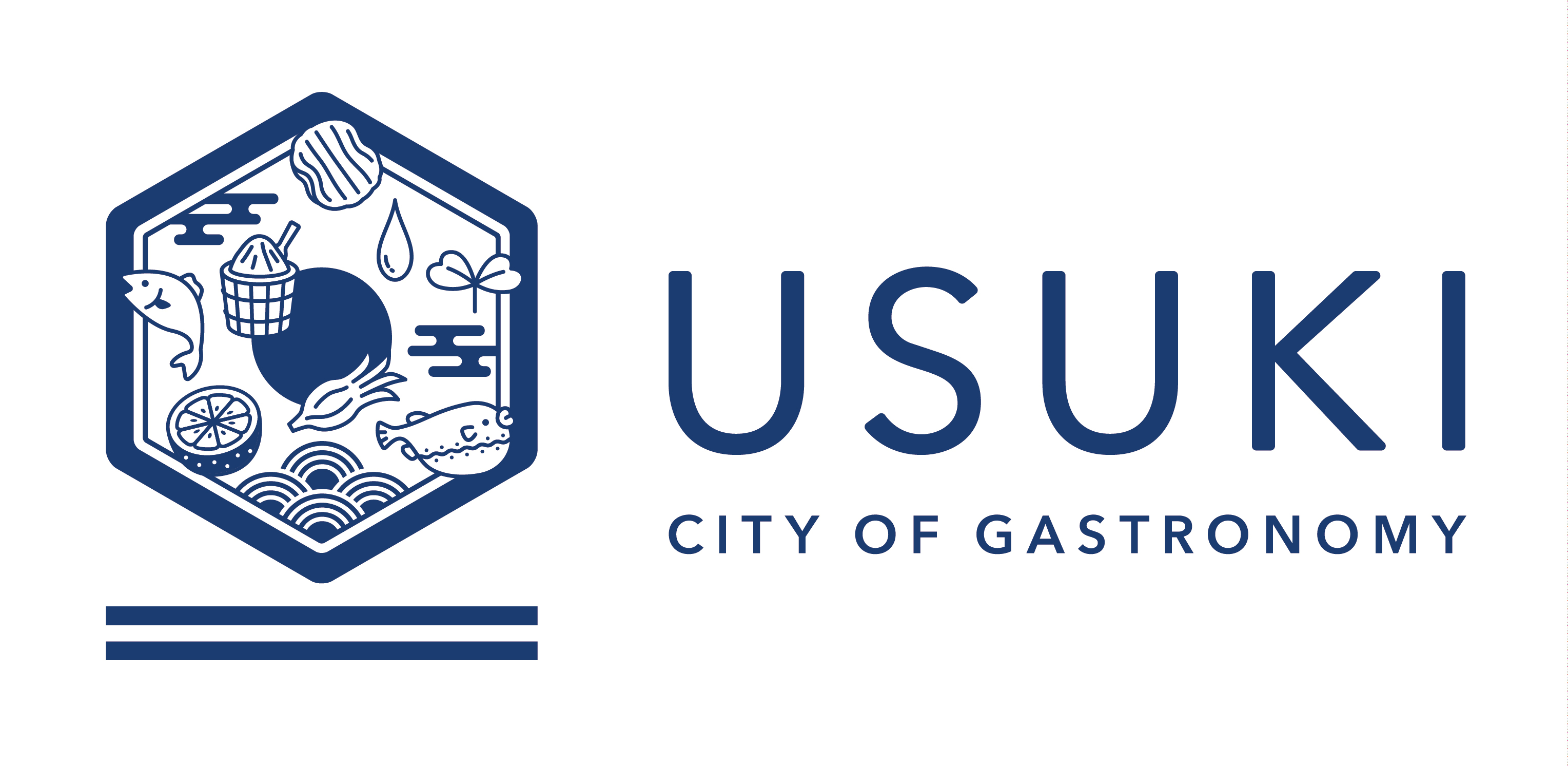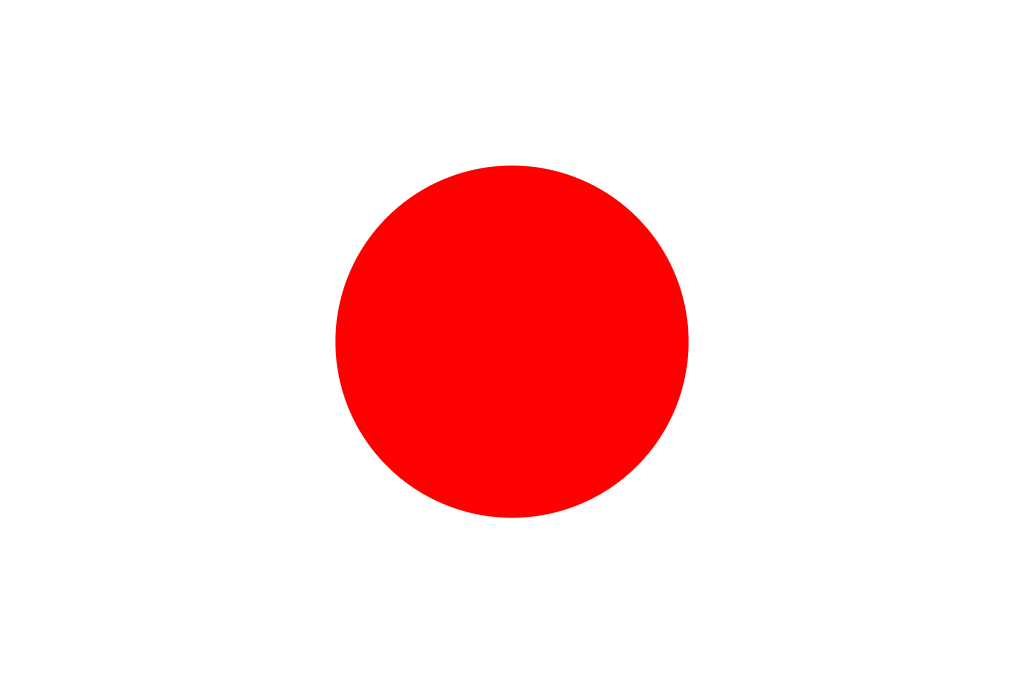Tokubetsu Junmai Mash (Moromi) 11 Days After the Third Stage of Shikomi - Tome-zoe (February 22, 2020)
The video shows our tokubetsu junmai mash (moromi) that is made with Wakamizu rice, a rice excellent for sake brewing from Usuki, 11 days after the third stage of shikomi - tome-zoe.
The fermentation has gone very well and there is a fruity scent in the air.
The joso is scheduled for around Saturday, March 7, but it depends on the how the fermentation is progressing.
Turning - Kirikaeshi (February 21, 2020)
10-12 hours after spreading the rice out (toko-momi), it’s turned in order to break it down where it has clumped together. We call this process kirikaeshi. The temperature can rise by up to 0.5℃ following the toko-momi process. Often, the kirikaeshi process is carried out using a machine because of the heat and humidity - it is hard work. However, at Kuge Honten, we do it manually. During kirikaeshi the temperature can drop by up to 2℃, but after this process is complete the rice will be mounded again (The video shows about half of the 150kgs of koji that will be used for the final stage, tome-zoe [regular sake]).
Seperating the Sedement - Ori-biki [Daiginjo Tobin] (February 19, 2020)
Immediately following the pressing (joso) process, the sake is cloudy as it contains large amounts of undissolved rice, starch granules, proteins, fibres, and other solids such as yeast and aspergillus.
The freshly pressed sake is left to stand, allowing the sediment to naturally settle at the bottom of the tank. The process is called ori-biki.
“The ori-biki process for the daiginjo is unusual. We use a thin hose to manually transfer the clear sake from one tobin to another, leaving the sediment in the original bottle”, said section chief - Mr. Murakami.
Daiginjo Sake Lees (February 17, 2020)
The automatic pressing machine: The machine consists of alternating filtration cloths and pressure panels. The latter have rubber airbags built in that will be inflated. The mash (moromi) is first pumped into the machine to be filtered, then compressed air is sent into the rubber airbags and the pressing takes place. (The video shows the pressing of our Honjozo).
Bagging the sake lees: The process of removing lees from the bags and the filter plates following joso is called kasuhanashi. When kasuhanashi is finished, we weigh the lees for testing. After that, they are sent to our product section, sorted, and manually packed in plastic bags ready for sale.
Our daiginjo sake lees has small black spots on it due to the aspergillus used, but this does not affect the quality at all. Daiginjo sake lees have a particularly delicious flavour.
Pressing - Joso | Hanging Bags | Daiginjo (February 13, 2020)
The second mash (moromi ) of daiginjo (Kumamoto yeast) was hung for pressing (joso). The taste was lighter than usual, probably because the rice proved difficult to dissolve.
After fermentation is complete, the mash (moromi) is pressed, separating the liquid (sake) from the solid part (lees). This process is called pressing (joso - agebune), and in this case, we use a tank or an automatic mash presser.
However, for the sake that we exhibit at appraisals (daiginjo), etc., we use a different pressing (joso) method. It involves hanging the mash in “sake bags” and allowing the sake to drip naturally, under its own weight, rather than using external pressure.
This is sometimes referred to as “Shizukuzake” or “Shizukudori” because the sake drips (shizuku) from canvas bags.
Since this kind of pressing doesn’t require external force to separate the sake from the sake lees, relying solely on the weight of the mash, this natural gentler press results in a delightful aroma and delicate taste.
In addition, the method of collecting the pressed sake in a special vessel called a tobin is known as “Tobindori” or “Tobinkakoi”.
Working on a Public Holiday (February 11, 2020)
1, Before joso, Toji Matsuno carefully cleans the automatic mash (moromi) compressor (the tank that receives the pressed sake), and the hoses.
2, We are also in the middle of preparing to make our tokubetsu junmai sake using Wakamizu rice, a rice cultivated in Usuki that is fantastic for sake brewing. In preparation for tomorrow’s steaming, the manufacturing section chief-Mr. Murakami is carrying Wakamizu rice to the rice steamer (koshiki).
3, The mash (moromi) using Kumamoto yeast (KA4)is likely to be ready for the joso process the day after tomorrow.
Rice Washing - Sen-mai (February 3, 2020)
The process of washing the white rice to remove all the remaining bran left following polishing is called sen-mai. During washing, the rice grains rub against each other, removing 1-2% of the surface, so the washing process also has the effect of a secondary rice polishing.
During sen-mai, potassium, protein, and starch granules are all released from the rice. The rice will absorb some of the water, increasing its volume by 10-15%
In the video you can see the rice washing process (in order):
90kgs of rice for the honjozo nakajikomi koji (using a mobile rice washer).
510kgs of rice for honjozo tomejikomi (using an automatic rice washer).
28kg of Wakamizu rice from Usuki City for the tokubetsu junmai shubo koji (hand washed).
The Sake Brewing has now Entered the Climatic Stage (February 1, 2020)
 |
 |
The brewers are having a busy morning. Even though the winter is mild, the temperature this morning in Usuki has dropped to 1℃.
In the photo on the left, you can see our energetic manufacturing section chief - Mr. Murakami.
In the photo on the right, Toji Matsuno, is disinfecting the yeast starter (shubo) tank with boiling water. On the right of the photo is the sake rice that is being moved to the rice steamer (koshiki).
The Second Stage - Naka-zoe (Nakajikomi ) for Honjozo (January 30, 2020)
The yeast has grown sufficiently during the “rest day” (odori), and the acidity is at around 2.7. The mash (moromi) is now ready for fermentation.
We will add some water, koji, and the steamed rice and give it a stir (The video shows the steamed rice).
The process of using a paddle to stir the mixture is called kaiire.
Care must be taken to stir the mixture gently with the kaiire (also the name of the paddle). The steamed rice will be crushed if it is stirred too vigorously.
We cool the steamed sake rice in a rice cooler and then it is added to the brewing tank using an “air-shooter”, a kind of air pump, that distributes the rice evenly. We made a video of the kaiire process.
熊本酵母と協会1801号の醪(令和2年1月29日)
Kumamoto Yeast Mash (Moromi) (11 Days After the Third Stage of Shikomi - Tome-zoe)
Occasionally, we see slightly large bubbles forming. Although this is a foamless yeast, a modest number of bubbles do form.
The stong apple-like ginjo aroma that was so potent on the third and fourth day has become milder.
Kyokai 1802 Yeast Mash (Moromi) (7 Days After the Third Stage of Shikomi - Tome-zoe)
Although this is a foamless yeast, a modest number of small bubbles have formed. There is a strong fruity ginjo scent, similar to pineapple, that fills the air.



 日本語
日本語